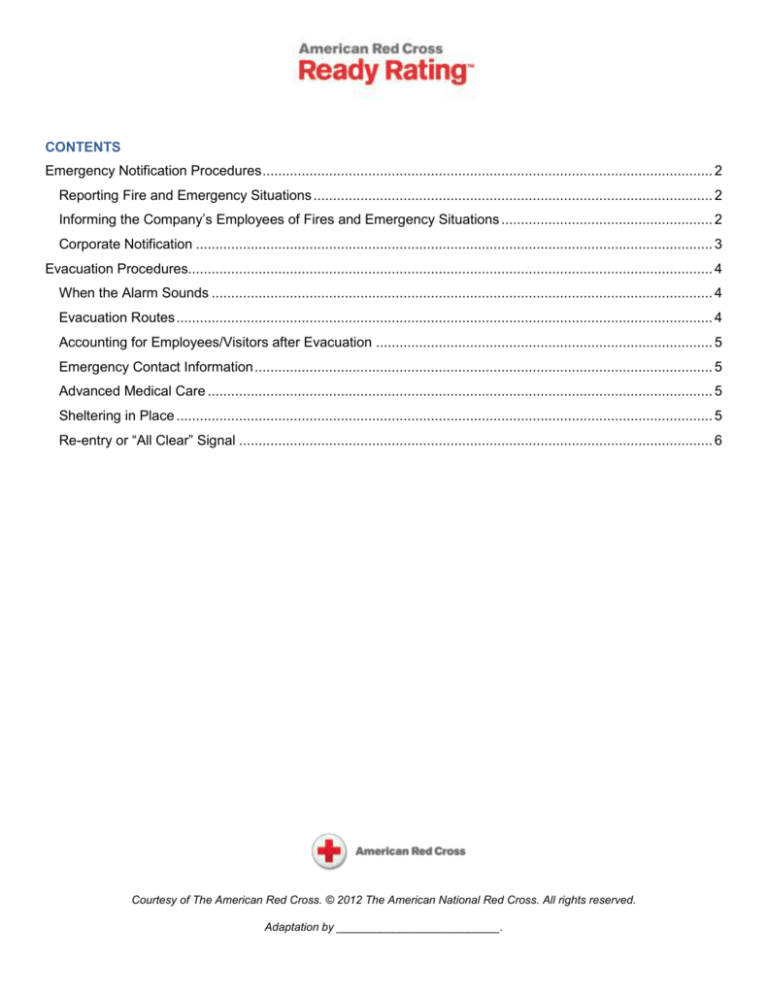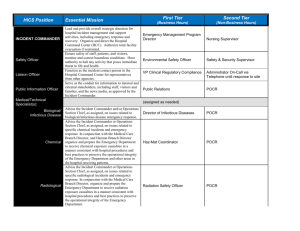
CONTENTS
Emergency Notification Procedures ................................................................................................................... 2
Reporting Fire and Emergency Situations ...................................................................................................... 2
Informing the Company’s Employees of Fires and Emergency Situations ...................................................... 2
Corporate Notification .................................................................................................................................... 3
Evacuation Procedures...................................................................................................................................... 4
When the Alarm Sounds ................................................................................................................................ 4
Evacuation Routes ......................................................................................................................................... 4
Accounting for Employees/Visitors after Evacuation ...................................................................................... 5
Emergency Contact Information ..................................................................................................................... 5
Advanced Medical Care ................................................................................................................................. 5
Sheltering in Place ......................................................................................................................................... 5
Re-entry or “All Clear” Signal ......................................................................................................................... 6
Courtesy of The American Red Cross. © 2012 The American National Red Cross. All rights reserved.
Adaptation by __________________________.
Emergency Notification Procedures
Reporting Fire and Emergency Situations
All fires and emergency situations will be reported as soon as possible to 911, the organization’s Incident
Commander, or an Incident Command Team (ICT) Member, by one of the following means:
Verbally, as soon as possible, during normal work hours; or
By telephone, if after normal work hours or on weekends.
NOTE: To eliminate confusion and the possibility of false alarms, some organizations only allow an ICT
Member or the designated substitute to contact the appropriate community emergency response
personnel. Each organization should decide which procedure is appropriate for them. Many
organizations prefer to have the discoverer of an emergency directly contact 911 in an effort to save
time. They rely on constant training to reduce the chance of false alarms.
The telephone numbers and contact information for emergency response personnel are:
Fire: Emergency: Dial 911; Non-emergency dial <insert local number here>
Police/Sheriff: Emergency: Dial 911; Non-emergency dial <insert local number here>
Ambulance/EMS: Dial 911
Under no circumstances shall an employee attempt to fight a fire that has passed the incipient stage (that
which can be put out with a fire extinguisher), nor shall any employee attempt to enter a burning building to
conduct search and rescue. These actions shall be left to emergency services professionals who have the
necessary training, equipment, and experience (such as the fire department or emergency medical
professionals). Untrained individuals may endanger themselves and/or those they are trying to rescue.
Informing the Company’s Employees of Fires and Emergency Situations
In the event of a fire or other emergency situation, the Incident Commander, or designee(s), shall
ensure that all employees are notified as soon as possible using the building’s alarm system and all
other non-ambiguous audible and visual alarms.
The Incident Commander, or designee(s), shall provide special instructions to all employees via the
public address system, by use of a portable “Bull Horn” loudspeaker, if available, or by whatever other
safe means of communication are available.
If a fire or emergency situation occurs after normal business hours, the company’s Incident
Commander, or designee, shall contact all employees not on shift and advise them of the status of
future work.
Courtesy of The American Red Cross. © 2012 The American National Red Cross. All rights reserved.
Adaptation by __________________________.
Corporate Notification
The Incident Commander, or designee(s), shall contact the company public relations resource as soon
as possible if media coverage of the situation is expected.
The Incident Commander, or designee(s), shall contact the main office as soon as possible with
information on employee injuries and/or loss of life, property damages, theft, or substantial losses.
Courtesy of The American Red Cross. © 2012 The American National Red Cross. All rights reserved.
Adaptation by __________________________.
Evacuation Procedures
When the Alarm Sounds
Do not stop for valuables or to get a coat or to turn off lights;
Shut off your equipment;
Close doors and windows;
If you lock your door, take your keys with you;
Alert others around you;
Assist any special needs people in evacuating;
When evacuating WALK, never run, and keep to the right of the hallways;
Leave the building, even if the alarm stops while you are on your way out;
Once outside, move away from the building and proceed to the designated assembly location. Do not
block firefighters or their equipment. In inclement weather go inside the designated assembly location.
Look for those who work with you to insure everyone has evacuated;
Give any information about the fire or persons who might still be in the building to your Fire Warden, the
Fire Department, or Police;
Do not re-enter the building for any reason until told to do so by the Incident Commander, or
designee(s),
Evacuation Routes
Emergency evacuation escape route plans are posted in several locations throughout the facility and
near offices.
In the event that a fire/emergency alarm is sounded or instructions for evacuation are given by the
Incident Commander, or designee(s), all employees shall immediately exit the building(s) at the nearest
exits as shown in the escape route plans, and shall meet as soon as possible at the designated
assembly area.
Employees with offices shall close the doors (unlocked) as they exit the area.
Courtesy of The American Red Cross. © 2012 The American National Red Cross. All rights reserved.
Adaptation by __________________________.
Accounting for Employees/Visitors after Evacuation
Once an evacuation has occurred, the Incident Commander, or designee(s), shall account for each
employee/visitor assigned to them at the designated assembly area.
Each employee is responsible for reporting to the appropriate supervisor san accurate head count can
be made.
All employee counts shall then be reported to the Incident Commander as soon as possible.
Emergency Contact Information
The Incident Commander, or designee(s), shall maintain a list of all employees’ personal emergency contact
information and shall keep the list to allow for easy access in the event of an emergency.
Advanced Medical Care
Under no circumstances shall an untrained employee provide advanced medical care and treatment.
These situations shall be left to emergency services professionals, who have the necessary training,
equipment, and experience.
Untrained individuals may endanger themselves and/or those they are trying to assist.
Sheltering in Place
In the event that the plant is threatened by severe weather or tornado warning, or that chemical or other
hazardous contaminants are released in to the environment in such quantity and/or proximity to the facility,
authorities and/or the Incident Commander, or designee(s), may determine that is safer to remain indoors
rather than to evacuate employees. It may also be the determination that in case of any workplace violence it
may be appropriate to shelter in place. The Incident Commander shall announce shelter in place status by
public address system.
The Incident Commander, or designee(s), (s) shall immediately close the business. If there are
customers/clients, or visitors in the building, they shall be advised to stay in the building for their safety.
Unless there is an imminent threat, employees, customers, clients, and visitors shall call their
emergency contacts to let them know where they are and that they are safe. The Incident Commander,
or designee(s), at the assembly point will remind those gathered of this required action.
The Incident Commander, or designee(s), shall turn on call-forwarding or alternative telephone
answering systems or services. The recording for voice mail or automated attendant shall be changed
to indicate that the business is closed, and that staff and visitors will be remaining in the building until
authorities advise that it is safe to leave.
The Incident Commander, or designee(s), and designated assistants shall quickly lock exterior doors
and close windows, air vents, and fireplace dampers. The Incident Commander, or designee(s), familiar
Courtesy of The American Red Cross. © 2012 The American National Red Cross. All rights reserved.
Adaptation by __________________________.
with the building’s mechanical systems shall turn off, seal, or disable all fans, heating and air
conditioning systems, especially those systems that automatically provide for exchange of inside air
with outside air.
The Incident Commander, or designee(s), shall gather essential disaster supplies (i.e., battery-powered
radios, first aid supplies, flashlights, batteries) and bring them to the shelter-in-place location within the
building. These items are stored the following location <insert location here>.
All employees, customers, and visitors shall move immediately to the shelter in place location(s) within
the building. The Incident Commander, or designee(s), shall seal all windows, doors, and vents with
plastic sheeting and duct tape.
The Incident Commander, or designee(s), shall write down the names of everyone in the room, and call
the designated emergency contact outside of the building to report who is in the room, and their
affiliations with the organization (employee, visitor, and vendor).
The Incident Commander, or designee(s), shall monitor telephone, radio, television and Internet reports
for further instructions from authorities to determine when it is safe to leave the building.
Re-entry or “All Clear” Signal
Once the building has been evacuated, none shall re-enter the building for any reason, except for
designated and properly trained rescue personnel (such as fire department or emergency medical
professionals). Untrained individuals may endanger themselves and/or those they are trying to rescue.
All employees shall remain at the designated assembly area until the fire department or other
emergency response agency notifies the Incident Commander, or designee(s), that either:
o
The building is safe for re-entry, in which case personnel shall return to their workstations; or
o
The building/assembly area is not safe, in which case personnel shall be instructed by the
Company Incident Commander, or designee, on how/when to vacate the premises.
Courtesy of The American Red Cross. © 2012 The American National Red Cross. All rights reserved.
Adaptation by __________________________.







